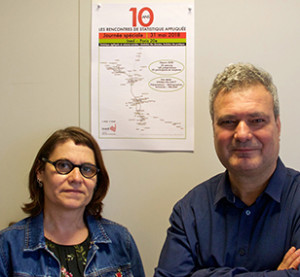Arnaud Bringé and Bénédicte Garnier
For the tenth anniversary of the Rencontres de Statistique Appliquée seminar, we interviewed Arnaud Bringé and Benédicte Garnier, statistics technicians at INED’s statistical methods department.

(Interview conducted in June 2018)
How is the seminar organized and what is discussed?
We set up this seminar in order to have a periodic meeting where practitioners could present several of the facets of applying a given statistical method, on the basis of concrete cases that illustrate a theory presented at the beginning of the session.
These presentations are primarily for researchers, technicians and PhD students at INED; also for other public or private sector analysts called upon to handle statistical problems in their research or particular studies.
The seminar also generates interaction between such disciplines as demography, epidemiology, sociology and economics. Practitioners’ distinct perspectives make it possible in a single session to compare not only statistical tools used but also hypotheses on methodology applications and types of published findings.
How have methods evolved in the last ten years?
Recent years have been marked by the massive amounts of data now available to statisticians, particularly in the social sciences. In this general context, access to administrative and health data, to take those examples, represents a major change that needs to be taken into account. This new access raises various questions, among them how to integrate these complex data alongside survey data that for many years have been traditionally analyzed in the social sciences.
Data today are increasingly heterogeneous in nature, and we need to integrate specific tools and methods alongside classic quantitative methods in order to process new data types such as internet-generated data, textual corpuses, and GPS data.
Taking these types of data into account, particularly Big Data, means we need to ensure that our practices evolve in order integrate them into all our research and statistical problematics.
All these points were discussed at our anniversary session at the end of May, the aim being to establish a complete list of potentially accessible types of data. We also discussed some of the methodological advances observed over the decade, such as micro-analytic simulation, sequence analysis, and multilevel modeling techniques, which make it possible to take an individual’s environment into account in explaining their behavior.
How would you assess these ten seminar years?
We organized approximately three half or full-day sessions a year, each on a single method. And over the ten years, we’ve had an average of around 50 participants at each. Some sessions were designed jointly with INED research teams or methodology groups.
In 2016 we created a seminar website where users can find recent presentations, bibliographies, seminar schedule announcements, and synopses of the 30 past sessions.
At the request of INED’s university laboratory partners, the seminar can now be accessed from outside, via videotelephony (available since 2014).
And INED’s upcoming move to Campus Condorcet will surely make it possible to further enlarge the seminar audience.
